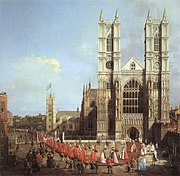|
Savoy Conference
The Savoy Conference of 1661 was a significant liturgical discussion that took place, after the Restoration of Charles II, in an attempt to effect a reconciliation within the Church of England. Proceedings It was convened by Gilbert Sheldon, in his lodgings at the Savoy Hospital in London. The Conference sessions began on 15 April 1661, and continued for around four months.[1] By June, a deadlock became apparent.[2] The conference was attended by commissioners: 12 Anglican bishops, and 12 representative ministers of the Puritan and Presbyterian factions. Each side also had nine deputies (called assistants or coadjutors). The nominal chairman was Accepted Frewen, the Archbishop of York. The object was to revise the Book of Common Prayer. Richard Baxter for the Presbyterian side presented a new liturgy, but this was not accepted. As a result the Church of England retained internal tensions about governance and theology, while a significant number of dissenters left its structure and created non-conformist groups retaining Puritan theological commitments. In 1662 the Act of Uniformity followed, mandating the usage of the 1662 Book of Common Prayer and spurring the Great Ejection. CommissionersThe nominated commissioners and deputies were as follows:[3]
For the presbyterians:
DeputiesOn the episcopal side there were:
On the presbyterian side there were:
There was to have been one more deputy on the presbyterian side, Roger Drake. A clerical error caused his name to appear as "William Drake" in the official document, and he did not actually attend.[4] Publications
References
|
